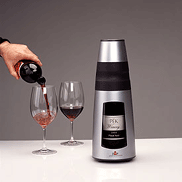
« PREVIOUS ENTRY
Mystery of bee flight finally solved
NEXT ENTRY »
A new elevator algorithm

Here’s a cool device: The Pek Wine Steward, which preserves a half-drunk bottle of wine by pumping argon gas into an airtight metal chamber. In his always-fun gadget column for the Sunday New York Times, Brendan Koerner wrote a terrific story about the guy who invented it:
He spent months fine-tuning a gas injection system. “We used computational fluid dynamics to model the gas flow,” Mr. Luzaich said, referring to a computer-analysis technique that measures how smoothly particles are flowing. The goal was to create an injector that could swap a bottle’s oxygen atoms for argon atoms; argon is an inert gas, and thus unlikely to harm a nice Chianti.
Indeed, argon is a particularly cool chemical — because it may become crucial in future attempts to colonize Mars. Argon, as it turns out, is pretty easy for humans to breathe without any ill effects. This is important because — as the Mars-exploration expert Penelope Boston has determined — any affordable attempt to terraform the Martian atmosphere is likely to retain a lot of argon in the mix. So she devised a little experiment to find out whether breathing argon is harmful or not: She sealed a bunch of mice in a little mouse Biosphere, with an atmosphere comprised of 20% oxygen, 40% nitrogen, and 40% argon. That’s way more argon than we breathe on Earth, where argon represents less than 1.6% of the mix. Yet the mice survived and thrived breathing that large amount of argon.
Okay, that’s probably enough Fun Argon Facts for today.
I'm Clive Thompson, the author of Smarter Than You Think: How Technology is Changing Our Minds for the Better (Penguin Press). You can order the book now at Amazon, Barnes and Noble, Powells, Indiebound, or through your local bookstore! I'm also a contributing writer for the New York Times Magazine and a columnist for Wired magazine. Email is here or ping me via the antiquated form of AOL IM (pomeranian99).

ECHO
Erik Weissengruber
Vespaboy
Terri Senft
Tom Igoe
El Rey Del Art
Morgan Noel
Maura Johnston
Cori Eckert
Heather Gold
Andrew Hearst
Chris Allbritton
Bret Dawson
Michele Tepper
Sharyn November
Gail Jaitin
Barnaby Marshall
Frankly, I'd Rather Not
The Shifted Librarian
Ryan Bigge
Nick Denton
Howard Sherman's Nuggets
Serial Deviant
Ellen McDermott
Jeff Liu
Marc Kelsey
Chris Shieh
Iron Monkey
Diversions
Rob Toole
Donut Rock City
Ross Judson
Idle Words
J-Walk Blog
The Antic Muse
Tribblescape
Little Things
Jeff Heer
Abstract Dynamics
Snark Market
Plastic Bag
Sensory Impact
Incoming Signals
MemeFirst
MemoryCard
Majikthise
Ludonauts
Boing Boing
Slashdot
Atrios
Smart Mobs
Plastic
Ludology.org
The Feature
Gizmodo
game girl
Mindjack
Techdirt Wireless News
Corante Gaming blog
Corante Social Software blog
ECHO
SciTech Daily
Arts and Letters Daily
Textually.org
BlogPulse
Robots.net
Alan Reiter's Wireless Data Weblog
Brad DeLong
Viral Marketing Blog
Gameblogs
Slashdot Games